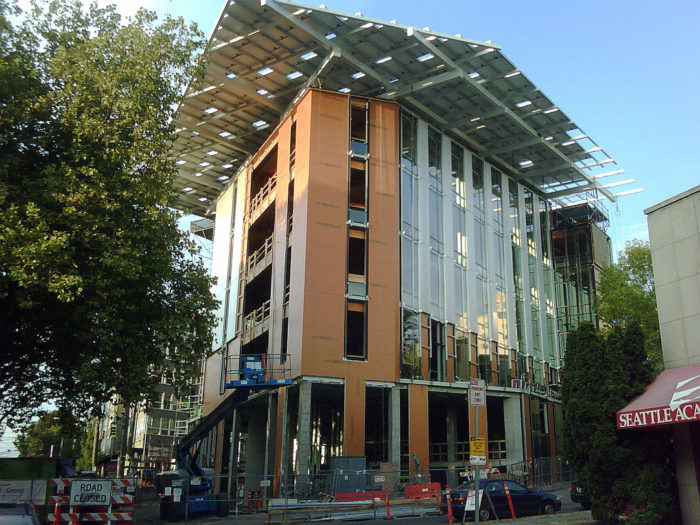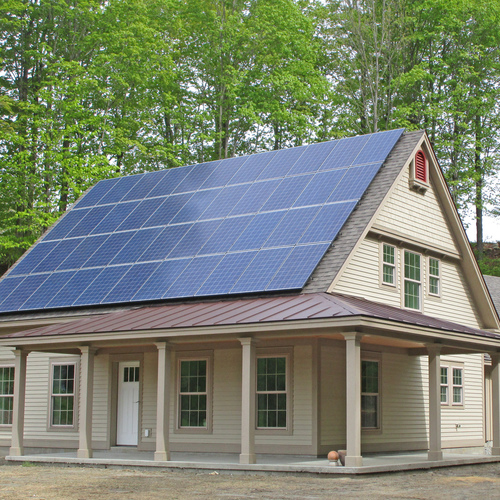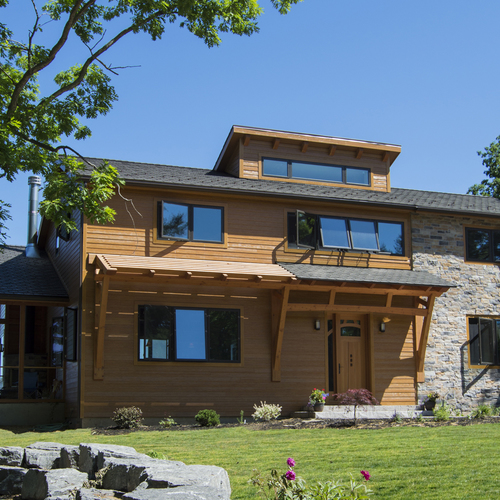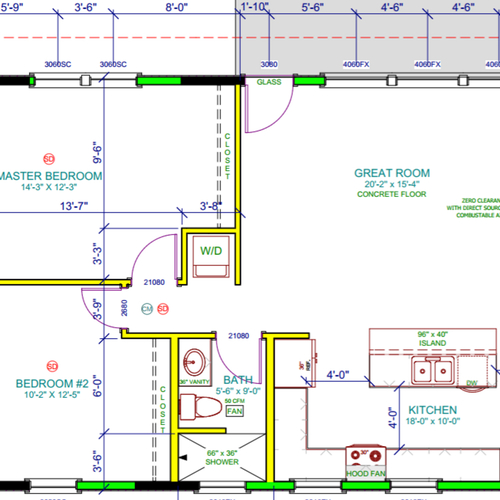
Image Credit: Joe Wolf / CC BY-ND 2.0 / Flickr
By SHILPA SANKARAN
Last month, we at the Net-Zero Energy Coalition (NZEC) published our second annual inventory of zero energy (ZE) residential buildings in the U.S. and Canada, titled “To Zero and Beyond: 2016 Residential Zero Energy Buildings Study.”
Prior to our first inventory report, existing data on residential zero energy was spotty. We believed it was crucial for us to quantify the current state and track progress in order to truly understand the reality of the zero energy movement.
So, how much has ZE homebuilding changed since the sun set on 2015? After our baseline inventory, that was the burning question. It turns out there is a large and rapidly growing ZE community out there across the continent, and a wealth of knowledge and insights embodied in those thousands of individuals and their projects. To access this knowledge via zero energy case studies from across the country, explore our online case study database. (If you want to submit a new project to the Net-Zero Energy Coalition, use this form.)
You can read our report to understand the details of the research. In this post, we explore further insights based on both our research and our first-hand experience in the industry (and what we really think).
The industry is risk-averse
Coming from the perspective of a consultant in many industry sectors, I have seen innovation diffusion ranging from slow (financial services) to light speed (high tech start-ups). But, even compared to the slower adopters of change, technology, and adaptation to market demands, I have not seen an industry more risk-averse than construction.
In 2007, when I entered into the industry, I charged ahead with zero energy, “offsite” (a.k.a. prefab) construction. Of course, we were met with great resistance then, and 10 years later the industry, sort of, is becoming more interested in this approach. I understand, firsthand, the perils of trying something new in this space. Margins are razor-thin, buyers are fickle, labor availability is unpredictable, material costs fluctuate, and economic cycles are a roller-coaster ride.
As such, NZEC found only a tiny percentage of the market – 8,203 residential units – are somewhere on the path to zero across the U.S. and Canada.
But, there are the pioneers. Unlike pioneers in the history books, these builders have found success after taking only small risks. Each one that comes next takes even less risk. We know how to get to zero in any climate zone for any type of home, so minimal R&D is required. Costs of high-performance materials and systems, and solar, are dropping. And the market is not only responding, but paying more.
These building pioneers have driven up zero energy construction by 33% in only one year. The number of projects has increased by 82% and projects in the pipeline for future zero energy comprise almost 30,000 units. And 95% of them didn’t do it because a buyer asked. They were built by multifamily developers and builders who just made the move.
These project teams are dedicated and inspiring for the movement. If you haven’t already, I highly recommend you take a look at the DOE Tour of Zero website. Here you will find beautiful photos, videos, and stories of the builders, giving you a more personal understanding of their approaches. It will be clear that we don’t need to be afraid of zero anymore.
There has been progress
The first zero energy project I was involved with in 2008 had landmines across the board. Contractors didn’t understand how to install and seal ductwork. We had to hack together an air-source heat-pump water heater. We created our own energy monitoring system and software. Nobody knew what zero energy was. The pioneers now have the “secret” knowledge that none of these issues exist anymore. With new, affordable technologies entering the market every day, and a plethora of training tools for contractors, zero is easier than it has ever been.
Don’t forget, the market is changing. Sixty-two percent of homebuyers are either millennials or boomers. They do not want big homes. They can’t afford them and don’t have the time to spend maintaining them. They do care about health and indoor air quality. They do care about the environment for future generations and themselves. They really care about saving money on energy bills. Millennials, in particular, care about having the latest and the coolest. The pioneers know this and are building their businesses around these assumptions in order to bolster the future of their companies.
Some perceive governments as entities that slow change and that exist to create constraints, especially when it comes to policies and codes for construction. Based on our research, this perception is completely untrue when it comes to zero energy.
Those states and local governments that have simply created aspirational targets (California) as well as incentives and competitions (Massachusetts) have stimulated market movement and economic growth that has exploded their respective markets. Our report shows 104% growth in ZE in California in the last year and 128% growth in Massachusetts.
Governments have the power to create a snowball effect
This growth is no mistake. These two states also represent the #1 and #2 states (by units) in both our 2015 and 2016 inventories. In 2007, the California Public Utilities Commission (CPUC) announced its goals to reach zero energy residential by 2020. In 2013, at our NZEC Summit in Irvine, California, builders and advocates from the state of Massachusetts came across members of the CPUC. They exchanged ideas and the Massachusetts contingent promptly went home to garner support for zero energy with the powers that be there. Soon after, the Massachusetts Department of Energy Resources (MDOER) announced its Pathways to Zero Net Energy Program.
A tiny state has placed #2 in zero energy in North America. Clearly, government efforts have stimulated massive change in this sector and set a trajectory in motion that can only go in one direction.
Likewise, cities are making great strides in setting zero energy goals across the country. After the U.S. pulled out of the Paris climate agreement, 30 mayors joined a group of 1,000 public and corporate leaders that is making commitments regardless of federal action. Of the top 20 zero energy cities in our research, 18 have local programs or are located within states that have zero energy programs.
Cities are not just a unilateral power. They are prompted and supported by grass roots movements that compel change. The city of Berkeley, California, is such an example where grassroots community group efforts led to “Berkeley Deep Green Building,” an incentive-based path toward buildings that meet Berkeley’s environmental and greenhouse gas reduction goals, including zero energy.
Whether a builder or developer with a project, a design professional pushing the envelope with clients, or a citizen who wants to drive change, our research shows it is all possible. You, too, can start a zero energy movement. With the current state of energy inefficient construction, we desperately need it.
NZEC will continue to conduct our annual inventory and hopes to see more upward gains due to movement-makers. To include your project in our next inventory, you can submit basic information via NZEC’s online form. It only takes a few minutes, and will contribute greatly to our collective knowledge of the zero energy movement.
Shilpa Sankaran is the executive director of the Net-Zero Energy Coalition.
Weekly Newsletter
Get building science and energy efficiency advice, plus special offers, in your inbox.














8 Comments
As the report mentions, "net
As the report mentions, "net zero energy" is inaccurate short hand for the things that we really care about. Unfortunately, it drives design decisions, causing inefficient allocation of funds.
I'd like to see something that incorporates these concepts:
1) When you use a kwh can make a big difference in environmental impact.
2) $1 spent on utility scale solar does more for the environment than $1 of residential solar. Ie, optimize outside of the arbitrary box of "the building".
Response to Jon R (Comment #10)
Jon,
You wrote, "$1 spent on utility scale solar does more for the environment than $1 of residential solar."
But that's not always true. A large utility-scale PV facility may require the upgrading of powerlines, while distributed PV (on residential rooftops) increases the grid's resiliency and reduces the need for investments in powerlines and other distribution hardware.
> while distributed PV (on
> while distributed PV (on residential rooftops) increases the grid's resiliency...
That's not always true either. For the average case of randomly located residential solar, I expect (but can't prove) that my statement is true.
Where do my electrons go?
When I produce surplus power on my roof, I assume that it gets delivered to my neighbors. Is that the case?
Response to Stephen Sheehy
Stephen,
As I'm sure you know, you really can't track individual electrons. But essentially, you're right: If your house is producing more power than it's using, and your next door neighbors are using more power than they are producing, then electricity will flow from your PV array (or, more accurately, from your inverter) to your neighbor's television or refrigerator.
For the random residential case... (@ Jon R)
""$1 spent on utility scale solar does more for the environment than $1 of residential solar."
.
.
"> while distributed PV (on residential rooftops) increases the grid's resiliency...
That's not always true either. For the average case of randomly located residential solar, I expect (but can't prove) that my statement is true."
In fact the inverse is true, for the random residential solar.
Almost all randomly located residential solar lowers the peak net load on the distribution grid, lowering the wear/fatigue of the transformers & wires, increasing local grid resilience. In lightly loaded/over-built sections of the distribution grid the value of the distributed solar is small, but still net positive for the distribution grid, and even those installations lower the peak load on the transmission grids. In most urban distribution grids the value of distributed generation is pretty high, more than offsetting the higher cost of residential PV compared to utility scale.
Distributed residential PV can add to the cost to the distribution & transmission grid when the amount of PV on a feeder exceeds the mid-day load on that section of the grid (by some large fraction) backfeeding power into substations not designed for two way power flows, but in the US that is a microscopic fraction of the total grid, relegated to a few neighborhoods on Oahu.
Utility scale solar almost always requires grid infrastructure upgrades for the interconnect, and does NOTHING to lower the peak load on the distribution grids. With careful siting & planning it can sometimes reduce peak loads on the transmission grid, but rare is the case where utility scale doesn't require some significant grid infrastructure for the interconnect, and that's typically built into the PPA price.
The grid infrastructure costs is typically more than half the cost of generating & delivering electricity, and distributed generation sited on the distribution grid in most cases bypasses the vast majority of that expensive grid infrastructure and it's associated costs (financial & environmental). So at even 2x the installed price, in the random case distributed PV clearly provides more financial benefit per dollar, and likely more environmental benefit (unless one defines the environmental benefit narrowly as offset greenhouse gas emissions.)
utility scale solar stills wins
See continuation here: https://www.greenbuildingadvisor.com/blogs/dept/guest-blogs/bringing-passive-house-production-building#comment-form
In Quebec , Quebec Hydro recently announced a large scale solar energy project. Apart from my distaste for the idea due to sentimental attachment to the "small is beautiful" credo, there are two good reasons for the development of decentralized power generation. Chances are high that the solar array will be plunked down on prime farmland. World food production is stagnating as the population shoots up. We need every scrap of farmland available. Also solar panels are usually produced in fairly small sizes and could be installed on rooftops where the power is needed. If solar panels were designed into every new building the pressure on the supply side of the grid would not increase and disasters like the major collapse of the supply lines we had in the '98 ice storm would not be nearly as severe. The maintenance of solar power supply would cost nothing to the utility because it would be up to the individual owner to look after his own units. The environmental disruption of existing rooftops is already a 'fait accompli' so the footprint of using rooftops for solar power would be negligible.
Log in or create an account to post a comment.
Sign up Log in